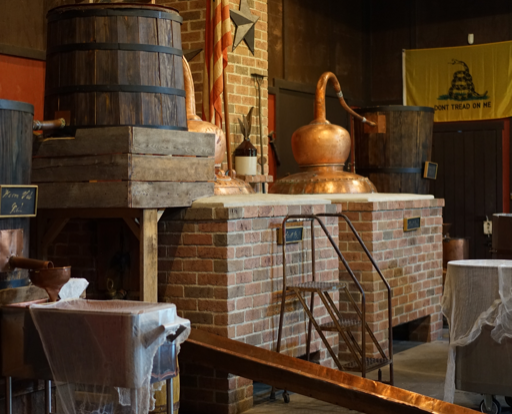Joe & Missy Duer
“Still the Same Still”
Joe Duer had always been fascinated by stories handed down through generations. He was fortunate to meet a woman who shared his passion for old-school craftsmanship, history, and whiskey. His partner, Missy (née Staley), was born into a lineage of distillers at the Staley Mill Farm, which was first founded in 1818 in New Carlisle, Ohio.
About the time Joe and Missy married, they discovered how Staley Mill Farm had come to be from a series of family records, ledgers, and letters. During the 1400s, the Staleys departed England amidst religious persecution and wound up in Holland. There, the next several generations of Staleys thrived for nearly 300 years. However, in 1737, as religious persecution once again forced them to flee their homeland, Jakob Staley chartered a ship named the “Charming Nancy.” Their group of religious reformers ultimately landed in Frederick, Maryland, American Colonies. There, Missy’s great-great-great-great-grandparents, Joseph and Julianne Staley, moved north to settle in Lancaster, Pennsylvania, and were part of an original family group that would later be known as the “Pennsylvania Dutch.” Joseph and Julianne had 16 children. Three of their more adventurous siblings were David, Henry, and Elias Staley, who ventured further west yet into the “Ohio Country.” The three brothers were all renowned millwrights, but Elias was also a distiller who eventually owned several distilleries around Dayton, Ohio. At the age of 24, he co-owned a particular one with a man named John Rench, who died unexpectedly, allowing Elias to buy the entire farm, which then came to be known as Staley Mill Farm. Elias Staley was Missy Duer’s great-great-grandfather.
David, Henry, and Elias Staley, circa 1880
Elias’s still—
—“Still” making spirits, better than ever!
For the next 45 years, Elias provided settlers and Native Americans with a grist mill for grinding their grain into flour. During its heyday, his distillery production ran 30–35 gallons of whiskey daily, with up to 100–400 barrels aging at a time. It provided liquor to local customers by the gallon jug, while barrels were purchased by saloons and general stores. Elias even delivered barrels of his whiskey to Union soldiers during the Civil War, though the cantankerous Elias halted production mid‑Civil War in protest of a federal whiskey excise tax, complaining that he “ain’t never paid a tax…”. Following Elias’ death in 1866, his sons Andrew, John, and Simon continued to operate the distillery. The operation remained very successful for nearly 100 years under George Washington Staley, Missy’s great-grandfather, until Prohibition put it out of business.
While dating, Joe and Missy realized that they both wanted to revive Elias Staley’s legacy. Despite money being scarce, the duo laid plans to reopen a distillery using the original copper pot stills and mash bills as Elias, which had remained hidden for over 90 years, and which he had carefully concealed from the authorities.
The Duer’s first years as a married couple involved continuing to pore over dusty documents and experimenting in makeshift trials, all while carefully restoring the stills. Missy’s early investment of time and frustration paid off when it was discovered that the stills needed only cleaning and minor soldering to return to operation. The couple leaned on both tradition and trial, making Elias’ original mash bill (65 % corn, 20 % rye, 15% barley) with local grains to recreate true pioneer whiskey. After reading a particularly confusing recipe, Joe joked that he had a “steep learning curve,” deciphering instructions like “heat your water and cool your water” from centuries-old correspondence. He noted that he didn’t even have a cow for milk to cool the mash, as the recipe suggested.
About the time the couple’s distilling dream took hold, their daughter Carmony was born. Finally, in 2010, Indian Creek Distillery at Staley Mill Farm was established. After navigating licensing, the distillery opened in 2013 and became Ohio’s first legal micro-distillery in almost 100 years. They projected an annual output of ~3,500 bottles and have been profiled in Wine Spectator as among the country’s most distinctive craft producers.
From early on, young Carmony spent her weekends in the tasting room, learning how to hand‑label bottles and even help dip them in wax. Some 15 years later and now a married woman herself, Carmony oversees bottling for Indian Creek Distillery. She is now poised to become the 7th-generation distiller, while the Duer’s youngest daughter, Sabra, also works at the distillery, making Indian Creek Distillery a true multi-generational family operation again. Joe has mastered the double copper pot method; Missy curates local rye, corn, spring water, and even heritage yeast. This all comes together to produce high-quality traditional spirits: Elias Staley White Rye, Staley Hickory Rye, Andy’s Old No. 5 Bourbon, and Dandy John’s Corn Whiskey.
With Indian Creek Distillery and Staley Mill Farm, Joe and Missy Duer didn’t just create whiskey; they revived a living museum. Their path wasn’t easy, but they believe that preserving this distilling heritage matters. Missy believes that she “carries whiskey in her blood,” and Joe brings the curiosity and grit needed to revive it sustainably for Carmony and future generations.
Today, the Duers stand at the helm of Ohio’s only historic‑artifact distillery: an authentic tribute to frontier American whiskey-making. They balance hard labor, deep respect for the past, and a warm family spirit. With 7 generations behind them and many ahead, Joe, Missy, Carmony, and Sabra continue to bottle more than spirits; they bottle history.
Contributed by Tracy McLemore, Fairview, Tennessee
References
Official Indian Creek Distillery website, www.indiancreekdistillery.com
The Alchemist Cabinet, Interview with Missy Duer of Indian Creek Distillery
OHLQ - Ohio Liquor, “Q & A with Missy Duer”. August 2022
Dayton Daily News, “Indian Creek Distillery Plans…”, Nancy Bowman, March 3, 2023







